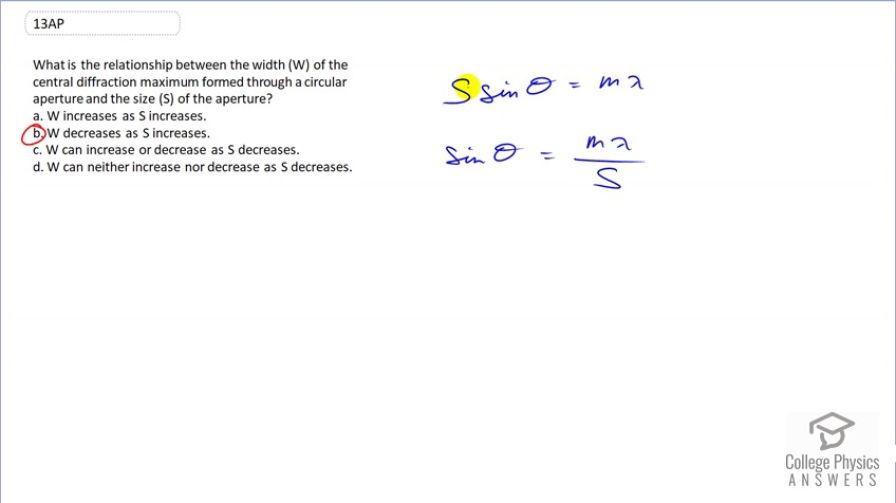Question
What is the relationship between the width (W) of the central diffraction maximum formed through a circular aperture and the size (S) of the aperture?
- W increases as S increases.
- W decreases as S increases.
- W can increase or decrease as S decreases.
- W can neither increase nor decrease as S decreases.
Final Answer
(b)
Solution video
OpenStax College Physics for AP® Courses, Chapter 27, Problem 13 (Test Prep for AP® Courses)

vote with a rating of
votes with an average rating of
.
Video Transcript
This is College Physics Answers with Shaun Dychko. his formula tells us what the diffraction pattern will be for light traveling through a slit normally or a circular aperture would work just as well. So we have the diameter of the circular aperture which is equivalent to slit width, if you have a rectangular aperture, and times sine theta. This is the angle to the first interference, destructive interference fringe. And that equals some integer one, negative one and so on. Times the wavelength. So we can see that sine theta then is m lambdaover S and we did that in order to figure out the relationship between this angle and the split width. And so this angle determines the width of the central diffraction maximum because if you have the slit here and then the screen over here you're going to have some destructive interference at this position and this position some angle theta with respect to the horizontal here. So this angle theta defines the width of the central maximum, two theta is the angular with that maximum. So we can see that w increases or w decreases the width of the central maximum decreases. Or in other words theta decreases as S increases. So as S increases this fraction gets smaller in which case the sine theta get smaller and therefore theta is smaller. Let's draw a picture of sine theta. Here’s sine theta and the most it can be is ninety though we’re only actually looking at this portion of the graph. So as S increases that means sine theta decreases and so Sine theta is the vertical axis here and theta is the horizontal axis. And so if you're decreasing sine theta, you're also decreasing theta because you know it since denser region of interest is here. That means we're moving to the left on the graph as we move to smaller sine theta values. So here's a small sine theta value. Here's a large sine theta value. So when you go from a high sine theta value which corresponds to this angle theta 2 and then moved to a smaller sine theta value that corresponds to a smaller angletheta 1. And so as sine theta decreases theta also decreases and as theta decreases the angular width decreases. So the angular width decreases as S increases. Answer is B.